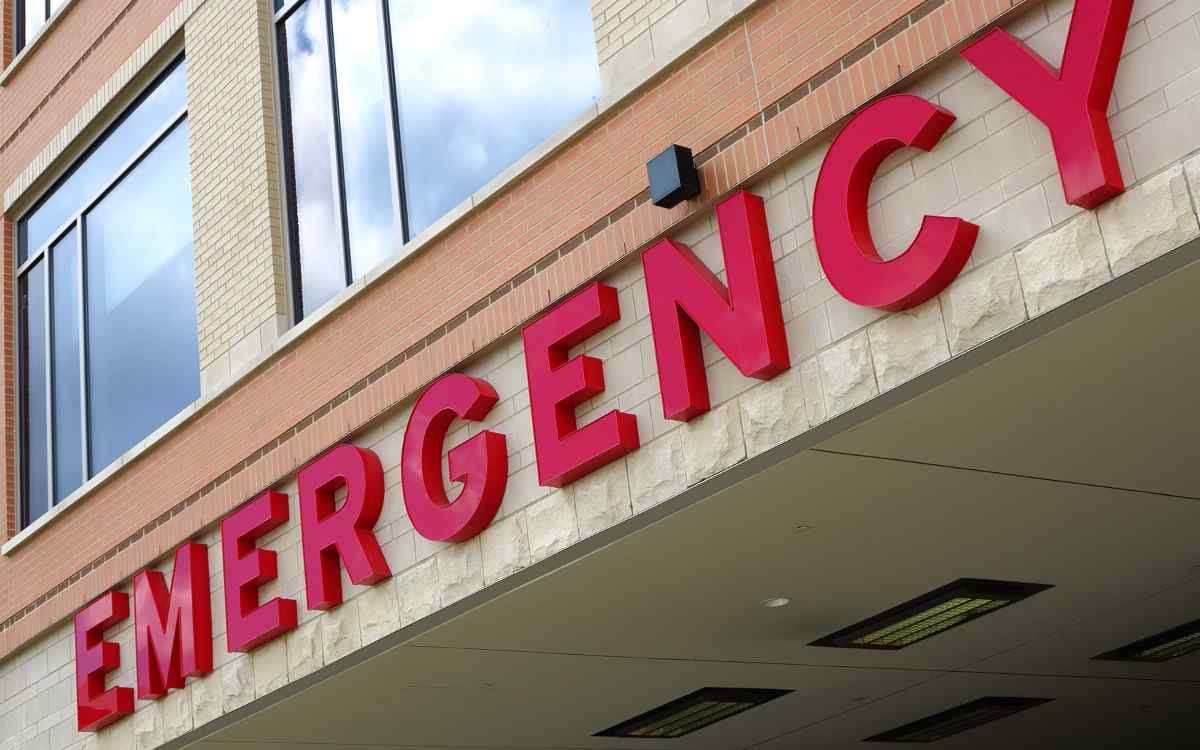How Much Is an Emergency Room Visit Without Insurance?
Fear of your emergency room visit cost should never keep you from getting the medical care you need. If you need to see a doctor, you should make it happen, no matter the expense. That said, it helps to know your emergency room cost so you can plan for it.

Over 140 million Americans visit the ER each year. Many ask, “How much is an emergency room visit?” Here is how much it costs.
National Average: The average cost of an emergency room visit in the U.S. ranges between $1,200 and $2,200 without insurance but can be as high as $3,000 or more depending on the treatment required.
Minor vs. Major Conditions: For less severe issues like sprains or minor cuts, visits can range from $150 to $1,000. More severe conditions, such as a heart attack or stroke, can cost up to $10,000 or more.
The cost can also vary depending on the location. Places like San Francisco and Miami tend to round out the top across the board, with some averages reaching as high as $4,573 and $3,974, respectively.
You can also try alternative spots to save money, such as urgent care, which is between $80 to $280, depending on the issue, which is more accessible than urgent emergencies.
You should consider going to the ER for acute, potentially life-threatening symptoms that need immediate attention. The common reasons to visit an emergency room include:
- Severe chest pain or heart attack symptoms
- Shortness of breath or difficulty breathing
- Uncontrollable bleeding or large, deep wounds
- Sudden or severe pain, especially in the head or abdominal area
- Major injuries like broken bones, burns, and head trauma
- Stroke symptoms, including slurred speech, sudden numbness, or paralysis
- High fever with confusion, rash, or seizures
- Severe allergic reaction-anaphylaxis-such as swelling of the face or trouble breathing
It is more convenient and economical to visit an urgent care center or make an appointment with your primary care provider for less urgent issues.
The steps in the ER begin with triage, where you will be given an Emergency Severity Index, or ESI, by a nurse. Cases are ranked from 1-5, 1 being life-threatening and 5 being minor issues. This system prioritizes how soon you are seen.
Less vital cases usually take longer to treat, especially during busy hours. You will be seen immediately for less severe issues, such as heart attacks or strokes.
The Average Cost of an ER Visit Without Insurance
The costs for the ER significantly differ depending on your services. If uninsured, this may be anywhere from $150 to $3,000 for a visit to the ER. Of course, more complex procedures, like diagnostics, stitches, or surgery, will increase those costs even further.
If someone has insurance, he may have to pay an out-of-pocket $50 to $150 copay, not considering the extra costs that could come if the ER is out of network. The good news is that even without insurance, federal law requires the hospital to treat you anyway. Of course, you are responsible for the bill, but most hospitals can offer some sort of financial assistance or allow payment plans to help soften the blow of the visit cost.
Cost Breakdown Tables
Please check our price breakdown tables for insight into how much it costs to visit the ER.
Cost by Condition
| Condition | Average ER Visit Cost (USD) |
| Chest Pain | $1,200 |
| Broken Bone (Fracture) | $2,500 |
| Respiratory Infection | $1,000 |
Cost by Diagnostic and Treatment Type
| Diagnostic/Treatment Type | Average ER Visit Cost (USD) |
| X-ray | $250 |
| CT Scan | $1,200 |
| MRI | $2,000 |
| Blood Test | $150 |
| EKG | $300 |
| IV Fluids | $500 |
Cost by Age Group
| Age Group | Average ER Visit Cost (USD) |
| 0-17 Years | $1,000 |
| 18-44 Years | $1,400 |
| 45-64 Years | $1,800 |
| 65+ Years | $2,000 |
Cost by Hospital Type
| Hospital Type | Average ER Visit Cost (USD) |
| Public Hospital | $1,200 |
| Private Hospital | $2,200 |
| Academic/Teaching Hospital | $2,500 |
| Rural Hospital | $1,000 |
Cost by Geographic Region
| Geographic Region | Average ER Visit Cost (USD) |
| Northeast | $2,100 |
| Midwest | $1,700 |
| South | $1,600 |
| West | $2,300 |
Why are ER Bills So High?
It’s no secret that emergency room bills in the U.S. can reach jaw-dropping amounts, and these costs often come at the worst time — right after you have suffered an unfortunate event.
The price of an ER visit varies widely based on factors like the type of treatment, where you live, and the hospital’s internal pricing policies. If you don’t have insurance, charges can run from a few hundred to several thousand dollars. Even if you’re insured, you may still face high out-of-pocket costs due to deductibles, co-pays, or out-of-network fees.

Part of the reason ER care is so expensive is because emergency departments operate around the clock, requiring skilled medical staff on hand around the clock and equipment that’s always ready to use.
On top of that, hospitals often tack on administrative fees, known as “facility fees,” which can add hundreds or even thousands of dollars to a bill — even for relatively simple visits. Layer in the complexity of insurance negotiations, billing codes, and hospital overhead, and it’s easy to see why prices can soar.
Easing the Burden
Still, there are a few ways you might be able to ease the financial burden:
- Many non-profit hospitals are required by law to offer some form of financial assistance. The details vary, but if your income falls below a certain threshold, you may qualify for discounted or even waived fees. Ask about the hospital’s policies before you receive care, if possible.
- Don’t be afraid to work with the billing department to set up a payment plan. Many hospitals are open to reasonable installments, sometimes without interest. This approach can help prevent a big lump sum from hitting you all at once.
- It’s not uncommon to find mistakes — like double charges or costly items for services you didn’t receive. Request an itemized statement and go through it carefully. If something looks off, call the billing office and ask them to explain or correct it.
- If your situation isn’t life-threatening, consider options like urgent care centers, retail clinics, or telemedicine. These can often handle issues like minor infections, sprains, or skin conditions at a fraction of the cost of an ER visit.
Above all, keep the lines of communication open. Let your providers know about your financial concerns. They may direct you to resources, give you advice on payment options, or suggest community clinics or assistance programs. Feeling overwhelmed is normal, but asking questions and seeking help can go a long way toward managing these costs.
For uninsured patients, visiting the emergency room can be costly, especially for non-life-threatening conditions. The following options can be less expensive and get them the care they might need:
Urgent Care Centers: These are the best for minor injuries or illnesses that need immediate treatment but are not life-threatening, such as sprains, minor cuts, or infections. Urgent care visits are usually much more affordable than emergency room visits and provide similar care for non-life-threatening issues.
Community Health Clinics: The FQHCs, Federally Qualified Health Centers, and other local community health clinics offer sliding-scale fees according to income or lower fees. Community clinics may also provide routine checkups, vaccinations, and primary urgent care for the uninsured.
Retail Clinics: Most pharmacies and many big-box retailers, like CVS or Walgreens, offer in-store clinics that can treat minor ailments, such as colds, flu, or skin conditions. They usually have transparent pricing and are much more affordable than ER visits.
Telemedicine: Virtual doctor visits are great alternatives in non-life-threatening cases. Telemedicine services can diagnose and recommend further treatment options that may be cheaper than an ER visit.
Free or Low-Cost Medical Programs: Some cities and states grant free or subsidized health programs for low-income or uninsured patients. Look around for local programs that could offset some medical care costs.
How to Reduce ER Bills When You Don’t Have Insurance?
If you have gone to the ER and do not have insurance, here are some ways you might lower your bill:
- Negotiate the bill: Many hospitals will negotiate a bill if a patient is uninsured. Call the billing department and explain your financial situation to them. They can cut the overall price or give a discount.
- Request a payment plan: If you cannot pay the amount in one go, ask the hospital to set up a payment plan. In this way, you can pay the bill in reasonable installments with no further interest or penalties.
- Apply for financial assistance: Many hospitals provide financial aid to low-income or uninsured patients. Check whether you qualify for reduced or waived fees using your income level.
FAQ
How Much Do Most ER Visits Cost?
Well, it depends on the condition and the tests that may be required, but the average ER visit can range from $150 to more than $3,000 in the United States. Some treatments, like stitches or X-rays, may cost over $1,000. Needless to say, services tend to get quite expensive when they relate to more intensive procedures, including MRIs and surgeries.
Why Are ER Visits So Expensive?
Emergency rooms must be staffed 24/7 with highly specialized personnel, which is expensive. They also have to be supplied with lots of costly medical equipment. ERs are also required by law to treat all patients – even if they can't pay their bills – which raises everyone else's costs to cover uncompensated care. The bills for administrative expenses, diagnostic tests, and specialized treatments are even higher.
Is It Better To Go to the ER at Night or Morning?
While ERs operate 24/7, less urgent cases may be seen faster when the hospital is less busy – late at night or early in the morning. However, medical bills are the same, regardless of when you choose to go.
What Happens if You Go to the ER Without Insurance in California?
If you go to an ER in California without insurance, they must treat you due to the federal Emergency Medical Treatment and Labor Act. You are, however, responsible for the bill after treatment. Some hospitals give financial assistance or payment plans for those patients who cannot pay a bill in full. You might also be eligible for partial cost coverage with state programs, including Medi-Cal.





